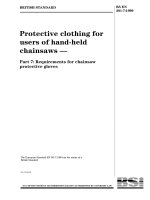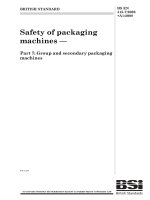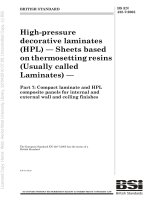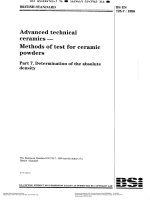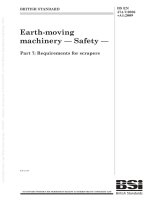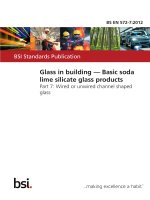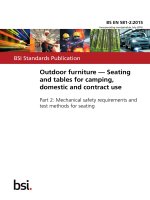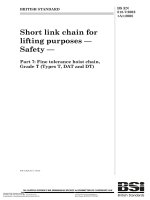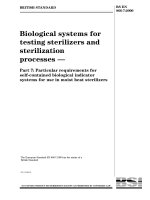Bsi bs en 61800 7 304 2016
Bạn đang xem bản rút gọn của tài liệu. Xem và tải ngay bản đầy đủ của tài liệu tại đây (4.13 MB, 98 trang )
BS EN 61800-7-304:2016
BSI Standards Publication
Adjustable speed electrical
power drive systems
Part 7-304: Generic interface and use of
profiles for power drive systems — Mapping
of profile type 4 to network technologies
BS EN 61800-7-304:2016 BRITISH STANDARD
National foreword
This British Standard is the UK implementation of EN 61800-7-304:2016. It
is identical to IEC 61800-7-304:2015. It supersedes BS EN 61800-7-304:2008,
which will be withdrawn on 12 October 2018.
The UK participation in its preparation was entrusted to Technical
Committee PEL/22, Power electronics.
A list of organizations represented on this committee can be obtained on
request to its secretary.
This publication does not purport to include all the necessary provisions of
a contract. Users are responsible for its correct application.
© The British Standards Institution 2016.
Published by BSI Standards Limited 2016
ISBN 978 0 580 82141 7
ICS 29.200; 35.100.05
Compliance with a British Standard cannot confer immunity from
legal obligations.
This British Standard was published under the authority of the
Standards Policy and Strategy Committee on 29 February 2016.
Amendments/corrigenda issued since publication
Date Text affected
EUROPEAN STANDARD BS EN 61800-7-304:2016
NORME EUROPÉENNE
EUROPÄISCHE NORM EN 61800-7-304
ICS 29.200; 35.100.05 February 2016
Supersedes EN 61800-7-304:2008
English Version
Adjustable speed electrical power drive systems -
Part 7-304: Generic interface and use of profiles for power drive
systems - Mapping of profile type 4 to network technologies
(IEC 61800-7-304:2015)
Entrnements électriques de puissance à vitesse variable - Elektrische Leistungsantriebssysteme mit einstellbarer
Partie 7-304: Interface générique et utilisation de profils Drehzahl - Teil 7-304: Generisches Interface und Nutzung
pour les entrnements électriques de puissance - Mise en von Profilen für Leistungsantriebssysteme (PDS) -
correspondance du profil de type 4 avec les technologies Abbildung von Profil-Typ 4 auf Netzwerktechnologien
de réseaux (IEC 61800-7-304:2015)
(IEC 61800-7-304:2015)
This European Standard was approved by CENELEC on 2015-12-25. CENELEC members are bound to comply with the CEN/CENELEC
Internal Regulations which stipulate the conditions for giving this European Standard the status of a national standard without any alteration.
Up-to-date lists and bibliographical references concerning such national standards may be obtained on application to the CEN-CENELEC
Management Centre or to any CENELEC member.
This European Standard exists in three official versions (English, French, German). A version in any other language made by translation
under the responsibility of a CENELEC member into its own language and notified to the CEN-CENELEC Management Centre has the
same status as the official versions.
CENELEC members are the national electrotechnical committees of Austria, Belgium, Bulgaria, Croatia, Cyprus, the Czech Republic,
Denmark, Estonia, Finland, Former Yugoslav Republic of Macedonia, France, Germany, Greece, Hungary, Iceland, Ireland, Italy, Latvia,
Lithuania, Luxembourg, Malta, the Netherlands, Norway, Poland, Portugal, Romania, Slovakia, Slovenia, Spain, Sweden, Switzerland,
Turkey and the United Kingdom.
European Committee for Electrotechnical Standardization
Comité Européen de Normalisation Electrotechnique
Europäisches Komitee für Elektrotechnische Normung
CEN-CENELEC Management Centre: Avenue Marnix 17, B-1000 Brussels
© 2016 CENELEC All rights of exploitation in any form and by any means reserved worldwide for CENELEC Members.
Ref. No. EN 61800-7-304:2016 E
BS EN 61800-7-304:2016
EN 61800-7-304:2016
European foreword
The text of document 22G/314/FDIS, future edition 2 of IEC 61800-7-304, prepared by
SC 22G “Adjustable speed electric drive systems incorporating semiconductor power converters” of
IEC/TC 22 “Power electronic systems and equipment" was submitted to the IEC-CENELEC parallel
vote and approved by CENELEC as EN 61800-7-304:2016.
The following dates are fixed:
• latest date by which the document has to be (dop) 2016-09-25
implemented at national level by (dow) 2018-12-25
publication of an identical national
standard or by endorsement
• latest date by which the national
standards conflicting with the
document have to be withdrawn
This document supersedes EN 61800-7-304:2008.
Attention is drawn to the possibility that some of the elements of this document may be the subject of
patent rights. CENELEC [and/or CEN] shall not be held responsible for identifying any or all such
patent rights.
Endorsement notice
The text of the International Standard IEC 61800-7-304:2015 was approved by CENELEC as a
European Standard without any modification.
In the official version, for Bibliography, the following notes have to be added for the standards indicated:
IEC 61158:2014 Series NOTE Harmonized as EN 61158:2014 Series.
IEC 61499-1:2005 NOTE Harmonized as EN 61499-1:2005 1) (not modified).
IEC 61800 Series NOTE Harmonized as EN 61800 Series.
IEC 61800-7 Series NOTE Harmonized as EN 61800-7 Series.
IEC 61800-7-1 NOTE Harmonized as EN 61800-7-1.
IEC 61800-7-201 NOTE Harmonized as EN 61800-7-201.
IEC 61800-7-202 NOTE Harmonized as EN 61800-7-202.
IEC 61800-7-203 NOTE Harmonized as EN 61800-7-203.
IEC 61800-7-301 NOTE Harmonized as EN 61800-7-301.
IEC 61800-7-302 NOTE Harmonized as EN 61800-7-302.
IEC 61800-7-303 NOTE Harmonized as EN 61800-7-303.
1) Superseded by EN 61499-1:2013 (IEC 61499-1:2012).
2
BS EN 61800-7-304:2016
EN 61800-7-304:2016
Annex ZA
(normative)
Normative references to international publications
with their corresponding European publications
The following documents, in whole or in part, are normatively referenced in this document and are
indispensable for its application. For dated references, only the edition cited applies. For undated
references, the latest edition of the referenced document (including any amendments) applies.
NOTE 1 When an International Publication has been modified by common modifications, indicated by (mod), the relevant
EN/HD applies.
NOTE 2 Up-to-date information on the latest versions of the European Standards listed in this annex is available here:
www.cenelec.eu
Publication Year Title EN/HD Year
IEC 61158-2 - Industrial communication networks - EN 61158-2 -
-
Fieldbus specifications - -
-
Part 2: Physical layer specification -
-
and service definition 2016
-
IEC 61158-4-16 - Industrial communication networks - EN 61158-4-16
Fieldbus specifications -
Part 4-16: Data-link layer protocol
specification - Type 16 elements
IEC 61158-5-16 - Industrial communication networks - EN 61158-5-16
IEC 61491 2002 2) Fieldbus specifications -
Part 5-16: Application layer service
definition - Type 16 elements
Electrical equipment of industrial -
machines - Serial data link for real-time
communication between controls and
drives
IEC 61784-1 - Industrial communication networks - EN 61784-1
Profiles -
Part 1: Fieldbus profiles
IEC 61784-2 - Industrial communication networks - EN 61784-2
Profiles -
Part 2: Additional fieldbus profiles for
real-time networks based on ISO/IEC
8802-3
IEC 61800-7-204 2015 Adjustable speed electrical EN 61800-7-204
power drive systems -
Part 7-204: Generic interface and use
of profiles for power drive systems -
Profile type 4 specification
ISO/IEC/IEEE 8802-3 2014 Standard for Ethernet -
2) Withdrawn publication.
3
– 2 – BS EN 61800-7-304:2016
IEC 61800-7-304:2015 © IEC 2015
CONTENTS
FOREW ORD ........................................................................................................................... 6
INTRODUCTION ..................................................................................................................... 8
1 Scope ............................................................................................................................ 12
2 Normative references .................................................................................................... 12
3 Terms, definitions and abbreviated terms ......................................................................12
3.1 Terms and definitions............................................................................................12
3.2 Abbreviated terms.................................................................................................18
4 General ......................................................................................................................... 18
5 Mapping to CP16/1 (SERCOS I) and CP16/2 (SERCOS II) ............................................19
5.1 Reference to communication standards.................................................................19
5.2 Overview............................................................................................................... 19
5.3 Physical layer and topology .................................................................................. 21
5.4 Synchronization mechanism.................................................................................. 22
5.4.1 General ......................................................................................................... 22
5.4.2 Handling of command and feedback values ...................................................23
5.4.3 Position loop with fine interpolator ................................................................. 24
5.5 Telegram contents ................................................................................................ 25
5.5.1 General ......................................................................................................... 25
5.5.2 Data block ..................................................................................................... 26
5.5.3 Communication function group telegrams ......................................................26
5.5.4 Standard telegrams .......................................................................................27
5.5.5 Application telegrams ....................................................................................29
5.6 Non-cyclic data transfer ........................................................................................ 30
5.7 Real-time bits........................................................................................................ 30
5.7.1 Functions of real time bits..............................................................................30
5.7.2 Allocation of real-time bits .............................................................................32
5.7.3 Possible cases .............................................................................................. 32
5.8 Signal control word and signal status word ...........................................................35
5.9 Data container ...................................................................................................... 36
5.10 Drive shutdown functions ...................................................................................... 38
5.11 Communication classes ........................................................................................ 39
5.11.1 General ......................................................................................................... 39
5.11.2 Communication class A .................................................................................40
5.11.3 Communication class B (Extended functions) ................................................42
5.11.4 Communication class C (Additional functions)................................................43
5.11.5 Communication cycle time granularity............................................................ 44
6 Mapping to CP16/3 (SERCOS III) .................................................................................. 44
6.1 Reference to communication standards.................................................................44
6.2 Overview............................................................................................................... 45
6.3 Physical layer and topology .................................................................................. 46
6.4 Synchronization mechanism and telegram content ................................................ 47
6.5 Non-cyclic data transfer ........................................................................................ 47
6.6 Communication cycles .......................................................................................... 48
6.7 Drive classes ........................................................................................................ 48
6.7.1 General ......................................................................................................... 48
6.7.2 Torque axis ................................................................................................... 49
BS EN 61800-7-304:2016 – 3 –
IEC 61800-7-304:2015 © IEC 2015
6.7.3 Velocity axis .................................................................................................. 50
6.7.4 Velocity axis with position feedback ...............................................................51
6.7.5 Position axis .................................................................................................. 53
6.7.6 Positioning axis ............................................................................................. 55
7 Mapping to EtherCAT .................................................................................................... 57
7.1 Reference to communication standards.................................................................57
7.2 Overview............................................................................................................... 57
7.3 SoE synchronization ............................................................................................. 58
7.3.1 General ......................................................................................................... 58
7.3.2 CP16 Phase 0-2 ............................................................................................ 59
7.3.3 CP16 Phase 3-4 ............................................................................................ 59
7.4 SoE Application Layer Management...................................................................... 59
7.4.1 EtherCAT State Machine and IEC 61784 CPF 16 State Machine ...................59
7.4.2 Multiple drives ............................................................................................... 60
7.4.3 IDN usage ..................................................................................................... 60
7.5 SoE Process Data Mapping .................................................................................. 61
7.6 SoE Service Channel Services..............................................................................64
7.6.1 Overview ....................................................................................................... 64
7.6.2 SSC Read ..................................................................................................... 64
7.6.3 SSC Write...................................................................................................... 68
7.6.4 SSC Procedure Commands ...........................................................................72
7.6.5 SSC Slave Info .............................................................................................. 75
7.7 SoE Coding general .............................................................................................. 76
7.8 SoE Protocol Data Unit Coding ............................................................................. 78
7.8.1 SSC Read ..................................................................................................... 78
7.8.2 SSC Write...................................................................................................... 82
7.8.3 Notify SSC Command Execution request .......................................................87
7.8.4 SSC Slave Info .............................................................................................. 88
Bibliography.......................................................................................................................... 90
Figure 1 – Structure of IEC 61800-7......................................................................................11
Figure 2 – Topology .............................................................................................................. 22
Figure 3 – Validity of command values and feedback acquisition time in the PDSs ..............23
Figure 4 – Synchronization of cycle times ............................................................................. 24
Figure 5 – Synchronization of the control loops and the fine interpolator ...............................25
Figure 6 – AT configuration (example) ..................................................................................30
Figure 7 – Function of the real-time bits ................................................................................32
Figure 8 – Allocation of IDN ≠ 0 to the real-time bits .............................................................33
Figure 9 – Allocation of IDN = 0 to the real-time bits .............................................................34
Figure 10 – Allocation of IDN ≠ 0 to the real-time bits ...........................................................35
Figure 11 – Configuration example of signal status word.......................................................36
Figure 12 – Data container configuration without acknowledge (slave) ..................................37
Figure 13 – Data container configuration with acknowledge (slave).......................................38
Figure 14 – Structure of communication classes ...................................................................39
Figure 15 – Topology ............................................................................................................ 46
Figure 16 – Telegram sequence............................................................................................47
Figure 17 – General communication cycle............................................................................. 48
– 4 – BS EN 61800-7-304:2016
IEC 61800-7-304:2015 © IEC 2015
Figure 18 – ESM and IEC 61158-4-16 State Machine ...........................................................59
Figure 19 – Successful SSC Read sequence ........................................................................ 65
Figure 20 – Unsuccessful SSC Read sequence ....................................................................65
Figure 21 – Successful SSC Fragmented Read sequence.....................................................66
Figure 22 – Successful SSC Write sequence ........................................................................69
Figure 23 – Unsuccessful SSC Write sequence.....................................................................69
Figure 24 – Successful SSC Fragmented Write sequence .....................................................70
Figure 25 – Successful SSC Procedure Command sequence ................................................73
Figure 26 – Aborted SSC Procedure Command sequence ....................................................74
Figure 27 – Slave Info sequence...........................................................................................75
Table 1 – CP16/1 and CP16/2 feature summary....................................................................19
Table 2 – Number of PDSs per network (examples) ..............................................................20
Table 3 – Communication Profile Interoperability within a network ........................................21
Table 4 – Typical operation data for cyclic transmission........................................................ 25
Table 5 – Typical data for non-cyclic transmission ................................................................ 26
Table 6 – IDN for choice and parameterisation of telegrams .................................................27
Table 7 – Structure of standard telegram-0 ...........................................................................27
Table 8 – Structure of standard telegram-1 ...........................................................................27
Table 9 – Structure of standard telegram-2 ...........................................................................27
Table 10 – Structure of standard telegram-3 .........................................................................28
Table 11 – Structure of standard telegram-4 .........................................................................28
Table 12 – Structure of standard telegram-5 .........................................................................29
Table 13 – Structure of standard telegram-6 .........................................................................29
Table 14 – IDN for configuration of MDT ............................................................................... 29
Table 15 – IDN for configuration of AT .................................................................................. 30
Table 16 – IDN for real-time bits ........................................................................................... 31
Table 17 – Real-time bits assignment IDNs...........................................................................31
Table 18 – IDN for configuring control and status words .......................................................35
Table 19 – Data containers IDN ............................................................................................ 36
Table 20 – Ring configuration – Timing .................................................................................40
Table 21 – Ring configuration – Telegram configuration........................................................40
Table 22 – Ring configuration – Phase run-up.......................................................................41
Table 23 – Service channel protocol ..................................................................................... 41
Table 24 – Information & diagnostics ....................................................................................41
Table 25 – Communication class A settings ..........................................................................42
Table 26 – Ring configuration – Telegram configuration........................................................42
Table 27 – Information & diagnostics ....................................................................................43
Table 28 – Real-time control bits .......................................................................................... 43
Table 29 – Real-time status bits............................................................................................43
Table 30 – Communication class B settings ..........................................................................43
Table 31 – CP16/3 features summary ...................................................................................45
Table 32 – Mandatory bit combinations of Drive control ........................................................49
BS EN 61800-7-304:2016 – 5 –
IEC 61800-7-304:2015 © IEC 2015
Table 33 – Mandatory bit combinations of Drive status .........................................................49
Table 34 – Supported operation mode ..................................................................................50
Table 35 – Supported torque/force scaling ............................................................................ 50
Table 36 – Supported operation mode ..................................................................................51
Table 37 – Supported velocity scaling ...................................................................................51
Table 38 – Supported operation mode ..................................................................................52
Table 39 – Supported position polarity ..................................................................................52
Table 40 – Supported velocity scaling ...................................................................................53
Table 41 – Supported position scaling .................................................................................. 53
Table 42 – Supported operation mode ..................................................................................54
Table 43 – Supported position polarity ..................................................................................54
Table 44 – Supported velocity scaling ...................................................................................54
Table 45 – Supported position scaling .................................................................................. 54
Table 46 – Supported torque/force scaling ............................................................................ 55
Table 47 – Supported operation mode ..................................................................................56
Table 48 – Supported position polarity ..................................................................................56
Table 49 – Supported velocity scaling ...................................................................................56
Table 50 – Supported position scaling .................................................................................. 56
Table 51 – Supported torque/force scaling ............................................................................ 57
Table 52 – Supported acceleration scaling............................................................................57
Table 53 – EtherCAT feature summary .................................................................................58
Table 54 – Number of PDSs per network (examples) ............................................................58
Table 55 – Obsolete IDNs ..................................................................................................... 60
Table 56 – Changed IDNs ..................................................................................................... 61
Table 57 – Status word of drive ............................................................................................ 62
Table 58 – Control word for drive .......................................................................................... 63
Table 59 – Mapping of SSC services to EtherCAT services...................................................64
Table 60 – SSC Read service ............................................................................................... 66
Table 61 – Read SSC Fragment service ...............................................................................68
Table 62 – SSC Write service ...............................................................................................70
Table 63 – Write SSC Fragment service ...............................................................................72
Table 64 – Notify SSC Command Execution service .............................................................74
Table 65 – SSC Slave Info service ........................................................................................ 76
Table 66 – SoE Mailbox protocol........................................................................................... 77
Table 67 – SSC Read request...............................................................................................79
Table 68 – SSC Read response ............................................................................................ 80
Table 69 – Read SSC Fragment request ...............................................................................81
Table 70 – SSC Write request...............................................................................................83
Table 71 – SSC Write response ............................................................................................85
Table 72 – Write SSC Fragment request ...............................................................................86
Table 73 – Notify SSC Command Execution request .............................................................88
Table 74 – Slave Info request ............................................................................................... 89
– 6 – BS EN 61800-7-304:2016
IEC 61800-7-304:2015 © IEC 2015
INTERNATIONAL ELECTROTECHNICAL COMMISSION
____________
ADJUSTABLE SPEED ELECTRICAL POWER DRIVE SYSTEMS –
Part 7-304: Generic interface and use of profiles for power
drive systems – Mapping of profile type 4 to network technologies
FOREWORD
1) The International Electrotechnical Commission (IEC) is a worldwide organization for standardization comprising
all national electrotechnical committees (IEC National Committees). The object of IEC is to promote
international co-operation on all questions concerning standardization in the electrical and electronic fields. To
this end and in addition to other activities, IEC publishes International Standards, Technical Specifications,
Technical Reports, Publicly Available Specifications (PAS) and Guides (hereafter referred to as “IEC
Publication(s)”). Their preparation is entrusted to technical committees; any IEC National Committee interested
in the subject dealt with may participate in this preparatory work. International, governmental and non-
governmental organizations liaising with the IEC also participate in this preparation. IEC collaborates closely
with the International Organization for Standardization (ISO) in accordance with conditions determined by
agreement between the two organizations.
2) The formal decisions or agreements of IEC on technical matters express, as nearly as possible, an international
consensus of opinion on the relevant subjects since each technical committee has representation from all
interested IEC National Committees.
3) IEC Publications have the form of recommendations for international use and are accepted by IEC National
Committees in that sense. While all reasonable efforts are made to ensure that the technical content of IEC
Publications is accurate, IEC cannot be held responsible for the way in which they are used or for any
misinterpretation by any end user.
4) In order to promote international uniformity, IEC National Committees undertake to apply IEC Publications
transparently to the maximum extent possible in their national and regional publications. Any divergence
between any IEC Publication and the corresponding national or regional publication shall be clearly indicated in
the latter.
5) IEC itself does not provide any attestation of conformity. Independent certification bodies provide conformity
assessment services and, in some areas, access to IEC marks of conformity. IEC is not responsible for any
services carried out by independent certification bodies.
6) All users should ensure that they have the latest edition of this publication.
7) No liability shall attach to IEC or its directors, employees, servants or agents including individual experts and
members of its technical committees and IEC National Committees for any personal injury, property damage or
other damage of any nature whatsoever, whether direct or indirect, or for costs (including legal fees) and
expenses arising out of the publication, use of, or reliance upon, this IEC Publication or any other IEC
Publications.
8) Attention is drawn to the Normative references cited in this publication. Use of the referenced publications is
indispensable for the correct application of this publication.
9) Attention is drawn to the possibility that some of the elements of this IEC Publication may be the subject of
patent rights. IEC shall not be held responsible for identifying any or all such patent rights.
International Standard IEC 61800-7-304 has been prepared by subcommittee SC 22G:
Adjustable speed electric drive systems incorporating semiconductor power converters, of IEC
technical committee TC 22: Power electronic systems and equipment.
This second edition cancels and replaces the first edition published in 2007. This edition
constitutes a technical revision.
This edition includes the following significant technical change with respect to the previous
edition: Update of mapping specification.
The text of this standard is based on the following documents:
FDIS Report on voting
22G/314/FDIS 22G/329/RVD
BS EN 61800-7-304:2016 – 7 –
IEC 61800-7-304:2015 © IEC 2015
Full information on the voting for the approval of this standard can be found in the report on
voting indicated in the above table.
This publication has been drafted in accordance with the ISO/IEC Directives, Part 2.
A list of all parts of the IEC 61800 series, under the general title Adjustable speed electrical
power drive systems, can be found on the IEC website.
The committee has decided that the contents of this publication will remain unchanged until
the stability date indicated on the IEC website under "" in the data
related to the specific publication. At this date, the publication will be
• reconfirmed,
• withdrawn,
• replaced by a revised edition, or
• amended.
IMPORTANT – The 'colour inside' logo on the cover page of this publication indicates
that it contains colours which are considered to be useful for the correct
understanding of its contents. Users should therefore print this document using a
colour printer.
– 8 – BS EN 61800-7-304:2016
IEC 61800-7-304:2015 © IEC 2015
INTRODUCTION
The IEC 61800 series is intended to provide a common set of specifications for adjustable
speed electrical power drive systems.
IEC 61800-7 specifies profiles for power drive systems (PDS) and their mapping to existing
communication systems by use of a generic interface model.
IEC 61800-7 describes a generic interface between control systems and power drive systems.
This interface can be embedded in the control system. The control system itself can also be
located in the drive (sometimes known as "smart drive" or "intelligent drive").
A variety of physical interfaces is available (analogue and digital inputs and outputs, serial
and parallel interfaces, fieldbuses and networks). Profiles based on specific physical
interfaces are already defined for some application areas (e.g. motion control) and some
device classes (e.g. standard drives, positioner). The implementations of the associated
drivers and application programmers interfaces are proprietary and vary widely.
IEC 61800-7 defines a set of common drive control functions, parameters, and state machines
or description of sequences of operation to be mapped to the drive profiles.
IEC 61800-7 provides a way to access functions and data of a drive that is independent of the
used drive profile and communication interface. The objective is a common drive model with
generic functions and objects suitable to be mapped on different communication interfaces.
This makes it possible to provide common implementations of motion control (or velocity
control or drive control applications) in controllers without any specific knowledge of the drive
implementation.
There are several reasons to define a generic interface:
For a drive device manufacturer
– less effort to support system integrators;
– less effort to describe drive functions because of common terminology;
– the selection of drives does not depend on availability of specific support;
For a control device manufacturer
– no influence of bus technology;
– easy device integration;
– independent of a drive supplier;
For a system integrator
– less integration effort for devices;
– only one understandable way of modeling;
– independent of bus technology.
Much effort is needed to design a motion control application with several different drives and
a specific control system. The tasks to implement the system software and to understand the
functional description of the individual components may exhaust the project resources. In
some cases, the drives do not share the same physical interface. Some control devices just
support a single interface which will not be supported by a specific drive. On the other hand,
the functions and data structures are often specified with incompatibilities. This requires the
system integrator to write special interfaces for the application software and this should not be
his responsibility.
BS EN 61800-7-304:2016 – 9 –
IEC 61800-7-304:2015 © IEC 2015
Some applications need device exchangeability or integration of new devices in an existing
configuration. They are faced with different incompatible solutions. The efforts to adapt a
solution to a drive profile and to manufacturer specific extensions may be unacceptable. This
will reduce the degree of freedom to select a device best suited for this application to the
selection of the unit which will be available for a specific physical interface and supported by
the controller.
IEC 61800-7-1 is divided into a generic part and several annexes as shown in Figure 1. The
drive profile types for CiA® 402 1, CIP MotionTM2, PROFIdrive3 and SERCOS®4 are mapped
to the generic interface in the corresponding annex. The annexes have been submitted by
open international network or fieldbus organizations which are responsible for the content of
the related annex and use of the related trade marks.
The different profile types 1, 2, 3 and 4 are specified in IEC 61800-7-201, IEC 61800-7-202,
IEC 61800-7-203 and IEC 61800-7-204.
This part of IEC 61800-7 specifies how the profile type 4 (SERCOS®) is mapped to the
network technologies SERCOS® and EtherCAT®5.
—————————
1 CiA® 402 is a registered trade mark of CAN in Automation e.V. (CiA). This information is given for the
convenience of users of this International Standard and does not constitute an endorsement by IEC of the trade
mark holder or any of its products. Compliance to this profile does not require use of the registered trade mark
CiA® 402. Use of the registered trade mark CiA® 402 requires permission of CAN in Automation e.V. (CiA).
2 CIP Motion™ is a trade mark of ODVA, Inc. This information is given for the convenience of users of this
International Standard and does not constitute an endorsement by IEC of the trade mark holder or any of its
products. Compliance to this profile does not require use of the trade mark CIP Motion™. Use of the trade mark
CIP Motion™ requires permission of ODVA, Inc.
3 PROFIdrive is a trade name of PROFIBUS & PROFINET International. This information is given for the
convenience of users of this International Standard and does not constitute an endorsement by IEC of the trade
name holder or any of its products. Compliance to this profile does not require use of the trade name
PROFIdrive. Use of the trade name PROFIdrive requires permission of PROFIBUS & PROFINET International.
4 SERCOS® is a regsistered trade mark of SERCOS International e.V. This information is given for the
convenience of users of this International Standard and does not constitute an endorsement by IEC of the trade
mark holder or any of its products. Compliance to this profile does not require use of the registered trade mark
SERCOS®. Use of the registered trade mark SERCOS® requires permission of the trade mark holder.
5 EtherCAT® is a registered trade mark of Beckhoff, Verl. This information is given for the convenience of users
of this International Standard and does not constitute an endorsement by IEC of the trade mark holder or any of
its products. Compliance to this profile does not require use of the registered trade mark EtherCAT®. Use of
the registered trade mark EtherCAT® requires permission of the trade mark holder.
– 10 – BS EN 61800-7-304:2016
IEC 61800-7-304:2015 © IEC 2015
IEC 61800-7-301, IEC 61800-7-302 and IEC 61800-7-303 specify how the profile types 1, 2
and 3 are mapped to different network technologies (such as CANopen® 6,
CC-Link IE® Field Network7, EPA™ 8, EtherCAT®, Ethernet PowerlinkTM9, DeviceNetTM10,
ControlNetTM11, EtherNet/IPTM12, PROFIBUS13 and PROFINET 14).
—————————
6 CANopen® is a registered trade mark of CAN in Automation e.V. (CiA). This information is given for the
convenience of users of this International Standard and does not constitute an endorsement by IEC of the trade
mark holder or any of its products. Compliance to this profile does not require use of the registered trade mark
CANopen®. Use of the registered trade mark CANopen® requires permission of CAN in Automation e.V. (CiA).
CANopen® is an acronym for Controller Area Network open and is used to refer to EN 50325-4.
7 CC-Link IE® Field Network is a registered trade mark of Mitsubishi Electric Corporation. This information is
given for the convenience of users of this International Standard and does not constitute an endorsement by
IEC of the trade mark holder or any of its products. Compliance to this profile does not require use of the
registered trade mark CC-Link IE® Field Network. Use of the registered trade mark CC-Link IE® Field Network
requires permission of Mitsubishi Electric Corporation.
8 EPA™ is a trade mark of SUPCON Group Co. Ltd. This information is given for the convenience of users of this
International Standard and does not constitute an endorsement by IEC of the trade mark holder or any of its
products. Compliance to this profile does not require use of the trade mark EPA™. Use of the trade mark
EPA™ requires permission of the trade mark holder.
9 Ethernet Powerlink™ is a trade mark of B&R, control of trade mark use is given to the non profit organization
EPSG. This information is given for the convenience of users of this International Standard and does not
constitute an endorsement by IEC of the trade mark holder or any of its products. Compliance to this profile
does not require use of the trade mark Ethernet Powerlink™. Use of the trade mark Ethernet Powerlink™
requires permission of the trade mark holder.
10 DeviceNet™ is a trade mark of ODVA, Inc. This information is given for the convenience of users of this
International Standard and does not constitute an endorsement by IEC of the trade mark holder or any of its
products. Compliance to this profile does not require use of the trade mark DeviceNet™. Use of the trade mark
DeviceNet™ requires permission of ODVA, Inc.
11 ControlNet™ is a trade mark of ODVA, Inc. This information is given for the convenience of users of this
International Standard and does not constitute an endorsement by IEC of the trade mark holder or any of its
products. Compliance to this profile does not require use of the trade mark ControlNet™. Use of the trade mark
ControlNet™ requires permission of ODVA, Inc.
12 EtherNet/IP™ is a trade mark of ODVA, Inc. This information is given for the convenience of users of this
International Standard and does not constitute an endorsement by IEC of the trade mark holder or any of its
products. Compliance to this profile does not require use of the trade mark EtherNet/IP™. Use of the trade
mark EtherNet/IP™ requires permission of ODVA, Inc.
13 PROFIBUS is a trade name of PROFIBUS &PROFINET International. This information is given for the
convenience of users of this International Standard and does not constitute an endorsement by IEC of the trade
name holder or any of its products. Compliance to this profile does not require use of the trade name
PROFIBUS. Use of the trade name PROFIBUS requires permission of PROFIBUS &PROFINET International.
14 PROFINET is a trade name of PROFIBUS &PROFINET International. This information is given for the
convenience of users of this International Standard and does not constitute an endorsement by IEC of the trade
name holder or any of its products. Compliance to this profile does not require use of the trade name
PROFINET. Use of the trade name PROFINET requires permission of PROFIBUS &PROFINET International.
BS EN 61800-7-304:2016 – 11 –
IEC 61800-7-304:2015 © IEC 2015
IEC 61800 series IEC TR 62390
Adjustable speed electrical power drive Device profile guideline
systems
IEC 61800-7 Generic interface and use of profiles for power drive systems
IEC 61800-7-1 – Interface definition
Generic PDS interface specification
Annex A Annex B Annex C Annex D
Mapping of Mapping of Mapping of Mapping of
Profile type 1 Profile type 2 Profile type 3 Profile type 4
(CiA 402) (CIP Motion) (PROFIdrive) (SERCOS)
IEC 61800-7-200 – Profile specifications
IEC 61800-7-201 IEC 61800-7-202 IEC 61800-7-203 IEC 61800-7-204
Profile type 1 Profile type 2 Profile type 3 Profile type 4
(CiA 402) (CIP Motion) (PROFIdrive) (SERCOS)
IEC 61800-7-300 – Mapping of profiles to network technologies
IEC 61800-7-301 IEC 61800-7-302 IEC 61800-7-303 IEC 61800-7-304
Mapping of profile Mapping of profile Mapping of profile Mapping of profile
type 1 to: type 2 to: type 3 to: type 4 to:
• CANopen • DeviceNet • PROFIBUS • SERCOS I + II
• CC-Link IE • ControlNet • PROFINET • SERCOS III
• EPA • EtherNet/IP • EtherCAT
• EtherCAT
• ETHERNET
Powerlink
IEC
Figure 1 – Structure of IEC 61800-7
– 12 – BS EN 61800-7-304:2016
IEC 61800-7-304:2015 © IEC 2015
ADJUSTABLE SPEED ELECTRICAL POWER DRIVE SYSTEMS –
Part 7-304: Generic interface and use of profiles for power
drive systems – Mapping of profile type 4 to network technologies
1 Scope
This part of IEC 61800 specifies the mapping of the profile type 4 (SERCOS) specified in
IEC 61800-7-204 onto different network technologies.
– SERCOS I / II, see Clause 5,
– SERCOS III, see Clause 6,
– EtherCAT, see Clause 7.
The functions specified in this part of IEC 61800-7 are not intended to ensure functional
safety. This requires additional measures according to the relevant standards, agreements
and laws.
2 Normative references
The following documents, in whole or in part, are normatively referenced in this document and
are indispensable for its application. For dated references, only the edition cited applies. For
undated references, the latest edition of the referenced document (including any
amendments) applies.
IEC 61158-2, Industrial communication networks – Fieldbus specifications – Part 2: Physical
layer specification and service definition
IEC 61158-4-16, Industrial communication networks – Fieldbus specifications – Part 4-16:
Data-link layer protocol specification – Type 16 elements
IEC 61158-5-16, Industrial communication networks – Fieldbus specifications – Part 5-16:
Application layer service definition – Type 16 elements
IEC 61491:2002, Electrical equipment of industrial machines – Serial data link for real-time
communication between controls and drives
IEC 61784-1, Industrial communication networks – Profiles – Part 1: Fieldbus profiles
IEC 61784-2, Industrial communication networks – Profiles – Part 2: Additional fieldbus
profiles for real-time networks based on ISO/IEC 8802-3
IEC 61800-7-204:2015, Adjustable speed electrical power drive systems – Part 7-204:
Generic interface and use of profiles for power drive systems – Profile type 4 specification
ISO/IEC/IEEE 8802-3:2014, Standard for Ethernet
3 Terms, definitions and abbreviated terms
3.1 Terms and definitions
For the purposes of this document, the following terms and definitions apply.
BS EN 61800-7-304:2016 – 13 –
IEC 61800-7-304:2015 © IEC 2015
3.1.1
acknowledge telegram
AT
telegram, in which each slave inserts its data
Note 1 to entry: The English abbreviation AT is also used in French.
3.1.2
algorithm
completely determined finite sequence of operations by which the values of the output data
can be calculated from the values of the input data
[SOURCE: IEC 61800-7-1:2015, 3.2.1]
3.1.3
application
software functional element specific to the solution of a problem in industrial-process
measurement and control
Note 1 to entry: An application may be distributed among resources, and may communicate with other
applications.
[SOURCE: IEC 61800-7-1:2015, 3.2.2]
3.1.4
attribute
property or characteristic of an entity
[SOURCE: IEC 61800-7-1:2015, 3.2.3]
3.1.5
class
description of a set of objects that share the same attributes, operations, methods,
relationships, and semantics
[SOURCE: IEC 61800-7-1:2015, 3.2.5]
3.1.6
commands
set of commands from the application control program to the PDS to control the behavior of
the PDS or functional elements of the PDS
Note 1 to entry: The behavior is reflected by states or operating modes.
Note 2 to entry: The different commands may be represented by one bit each.
[SOURCE: 61800-7-1:2015, 3.3.1.3]
3.1.7
communication cycle
accumulation of all telegrams between two master synchronization telegrams
3.1.8
control
purposeful action on or in a process to meet specified objectives
[SOURCE: 61800-7-1:2015, 3.2.6]
– 14 – BS EN 61800-7-304:2016
IEC 61800-7-304:2015 © IEC 2015
3.1.9
control device
control unit
physical unit that contains – in a module/subassembly or device – an application program to
control the PDS
[SOURCE: 61800-7-1:2015, 3.2.7]
3.1.10
control word
two adjacent bytes inside the master data telegram containing commands for the addressed
PDS
[SOURCE: IEC 61800-7-1:2015, 3.3.5.4, modified — The word "drive" is replaced by the word
"PDS".]
3.1.11
cycle time
time span between two consecutive cyclically recurring events
3.1.12
cyclic communication
periodic exchange of telegrams
3.1.13
cyclic data
part of the message which does not change its meaning during cyclic operation of the
interface
3.1.14
cyclic operation
devices in the communication network are addressed and queried one after the other at fixed,
constant time intervals
3.1.15
data exchange
demand dependent, non cyclic transmission of information after request was sent by the
master (service channel)
[SOURCE: 61800-7-1:2015, 3.3.5.7]
3.1.16
data type
set of values together with a set of permitted operations
[SOURCE: 61800-7-1:2015, 3.2.8]
3.1.17
device
field device
networked independent physical entity of an industrial automation system capable of
performing specified functions in a particular context and delimited by its interfaces
[SOURCE: 61800-7-1:2015, 3.2.9]
BS EN 61800-7-304:2016 – 15 –
IEC 61800-7-304:2015 © IEC 2015
3.1.18
device profile
representation of a device in terms of its parameters, parameter assemblies and behavior
according to a device model that describes the device’s data and behavior as viewed through
a network, independent from any network technology
[SOURCE: 61800-7-1:2015, 3.2.11]
3.1.19
fibre optic cable
transmission medium for serial data transmission of optical signals
3.1.20
functional element
entity of software or software combined with hardware, capable of accomplishing a specified
function of a device
Note 1 to entry: A functional element has an interface, associations to other functional elements and functions.
Note 2 to entry: A functional element can be made out of function block(s), object(s) or parameter list(s).
[SOURCE: 61800-7-1:2015, 3.2.13]
3.1.21
identification number
IDN
designation of operating data under which a data block is preserved with its attribute, name,
unit, minimum and maximum input values, and the data
Note 1 to entry: The English abbreviation IDN is also used in French.
3.1.22
input data
data transferred from an external source into a device, resource or functional element
[SOURCE: 61800-7-1:2015, 3.2.14]
3.1.23 functional characteristics, signal
interface
shared boundary between two entities defined by
characteristics, or other characteristics as appropriate
[SOURCE: 61800-7-1:2015, 3.2.15]
3.1.24
line
network topology in which the transmission medium is routed from station to station in the
form of a line
Note 1 to entry: The information is transmitted in one direction from the master down to the last slave in the line,
and then flows back to the master via all the slaves in the reverse order (CP16/3, CP12).
3.1.25
master
node, which assigns the other nodes the right to transmit
– 16 – BS EN 61800-7-304:2016
IEC 61800-7-304:2015 © IEC 2015
3.1.26
master data telegram
MDT
telegram, in which the master inserts its data
Note 1 to entry: The English abbreviation MDT is also used in French.
3.1.27 synchronization signal
master synchronization telegram
MST
telegram, or part of a telegram, in which the master inserts a time
Note 1 to entry: The English abbreviation MST is also used in French.
3.1.28
model
mathematical or physical representation of a system or a process, based with sufficient
precision upon known laws, identification or specified suppositions
[SOURCE: 61800-7-1:2015, 3.2.17]
3.1.29
non-cyclic transmission
non-periodic exchange of data at the request of the master
3.1.30
operating cycle
period of the control loop within the PDS or the control unit
3.1.31
operating mode
characterization of the way and the extent to which the human operator intervenes in the
control equipment
[SOURCE: 61800-7-1:2015, 3.2.18]
3.1.32
output data
data originating in a device, resource or functional element and transferred from them to
external systems
[SOURCE: 61800-7-1:2015, 3.2.19]
3.1.33
parameter
data element that represents device information that can be read from or written to a device,
for example through the network or a local HMI
Note 1 to entry: A parameter is typically characterized by a parameter name, data type and access direction.
[SOURCE: IEC 61800-7-1:2015, 3.2.20]
3.1.34
PDS enable
command to close the feedback loop(s)
3.1.35
PDS on
command that the power stage can be activated
